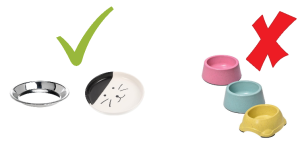Managing resources: food and water bowls
When visiting pet shops, the wide range of accessories can make choosing the right item somewhat tricky, especially when it comes to first-time cat owners.The design and aesthetics of the various accessories are often aimed at suiting the owners’ tastes rather than catering for the needs of the cats themselves. However, making the right choice is crucial, particularly for indoor cats sharing the space with other pets. Let’s explore the best way of handling something seemingly ordinary, like selecting the perfect cat bowl.
Food bowls
Which shape and size should you go for?
It is important that your cat always has two food bowls: one for wet food and another for dry food. Cats typically favor bowls that are shallow, wide, and rounded. This design prevents their whiskers from touching the edges, which can cause discomfort for the cat. Simple saucers are fine for wet food, while for dry food it is preferable to have a wide bowl with low edges.
You might well be thinking: ‘yes, but my cat happily eats from a tall, narrow bowl’. It is true that some cats will eat from smaller bowls. This behavior can be understood; if you were hungry, you might also eat from a bowl where it’s a bit challenging to reach your food. But here’s another perspective: try to imagine your state of mind while you are eating the food: you might easily feel frustrated or even irritated. Imagine having to repeat the same thing every day because you have no other choice. Instead, just think about how your mood would change if you could eat your meal in peace, simply enjoying the food, without worrying about the difficulty of getting to it. It would make quite a difference, wouldn’t it?

Which shape and size should you go for?
Which type of material should you choose?
Opting for ceramic or stainless-steel bowls over plastic is preferable, as plastic tends to retain odors over time, which can be unpleasant for your cat. Bear in mind that cats have a much more sensitive sense of smell than humans, allowing them to detect odors that may go unnoticed by us. It is recommended you wash bowls with mild soap and warm water and avoid using detergents with strong odors that could linger after washing.
Where should they be kept?
In a quiet spot, always ensuring there is a bit of space between the bowls and the nearby wall, as cats prefer to have a clear view of their surroundings while eating. By placing the bowls away from walls and corners, your cat can freely position themselves around the bowl, maintaining a sense of control over their environment and preventing them from feeling vulnerable or hurried during mealtime.
It is important to avoid placing food bowls near litter boxes, cat flaps, noisy appliances or places where people frequently walk past, as these locations may induce stress and anxiety, disrupting the mealtime experience.
Special consideration should be given to older cats. If they suffer from arthritis, joint issues, or mobility challenges, raised feeding stations and bowls can assist them in accessing food more comfortably.
What if there are dogs or there is more than one cat?
Cats and dogs have two different ways of accessing food, so it is very important that the cat can have a private, quiet place to eat whenever he or she wants to throughout the day that the dog cannot access.
For families with dogs, it is therefore important to place cat bowls out of reach, ideally on a shelf or a piece of furniture. Handy shelves with built-in bowls can also be installed, but remember that they must be wide enough for the cat to have enough space to climb up and position itself near the bowl.
In households with more than one feline, each cat should have its own bowls, placed in different areas of the house so that they can choose to eat in private away from each other, should they wish to do so. Cats don’t see mealtime as a social event: eating near another cat can cause stress and lead to coexistence issues.
Numerous images or videos are in circulation showing pictures of cats all eating together, yet signs of stress are often apparent upon closer observation. Colony cats, for example, all eat together not because they enjoy doing so, but because food is given to them in that specific way and at that particular time. Given a choice, they would most likely access food at different times and maybe in a way that avoids meeting certain individuals.
Imagine always having to eat lunch every day next to someone you are not very familiar with or who you don’t particularly like. While you wouldn’t abstain from eating if it was your only option, it wouldn’t be a relaxing experience, and you would no doubt try to finish as soon as possible to escape from a situation that makes you feel uncomfortable. Cats face similar discomfort when obliged to eat next to another feline with whom they may not have a good relationship.
The key lies in changing your perspective: be mindful of your cat’s mood. Learning to understand his or her emotional state and motivations when performing actions or making choices will make a big difference in your relationship with your cat, even concerning simple things like how to manage their bowls.
Water bowls: which ones to choose and where to place them
According to a 2018 study, nearly 60% of surveyed cats with outdoor access preferred drinking from outdoor sources such as watering cans, saucers or puddles rather than indoor bowls. However, it’s equally important for indoor cats to have access to fresh water daily, especially those on dry food diets.
How can we encourage indoor cats to drink enough water?
Cats tend to prefer drinking from separate locations than where they eat, so it’s a common mistake to place water bowls next to food bowls or use dual-purpose bowls. It’s essential to keep food and water areas separate.
Food and water should be in separate areas. Place the water bowl in a different corner of the room from the one dedicated to food. Better still, provide multiple water bowls in different parts of the house and perhaps a saucer and a bowl on a balcony (if accessible).
Opt for high-rimmed ceramic or stainless-steel bowls, and experiment with different diameters to see which type your cat prefers. Always fill them at least three-quarters full, because cats drink by using their tongues like spoons and need sufficient depth to do so comfortably.
Avoid plastic bowls, as they can release chemicals that alter the taste of the water, and cats possess a taste sensitivity as acute as their sense of smell!
Some cats enjoy running water from a tap, others like drinking from glasses, while you could even provide your cat with a water fountain. Offering different options and observing your cat’s preferences is the winning combination.
Look how Giovanni, one of our cats in Romania, likes to drink!
